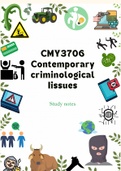Summary
Summary CMY3706 - Contemporary Criminological issues Study Notes
- Course
- Institution
Study notes are made in color for better understanding. Short but with all the important info. Very complete. No more reading through the whole book. Use these study notes with the self-assessment questions in your book and past papers to guarantee a good mark. Good luck!
[Show more]



